Mystical fortune of Andrew Carnegie
A tale of taweez and triumph

Andrew Carnegie, known as one of the most successful industrialists of the late 19th and early 20th centuries, is often remembered for his significant contributions to the American steel industry and his extensive philanthropy. However, in this article, we explore how Carnegie's success is intertwined with his use of Islamic talismans, known as taweez, said to be prepared for him by a Turkish Sufi mystic.
The meeting with the sufi mystic (1872)
The story begins in 1872, when Carnegie, already a rising figure in the industrial world, encountered a turkish sufi mystic during his travels in Istanbul. Intrigued by Sufi teachings and the mystic's knowledge, Carnegie was presented with a taweez inscribed with verses believed to bring prosperity and protection. This meeting marked the beginning of Carnegie's journey with the mystical world of taweez.
The taweez and the steel empire (1873-1892)
As Carnegie ventured further into the steel industry, he kept the taweez close, often tucked within his vest pocket. The year following his encounter with the Sufi, Carnegie launched his first steel mill, the Edgar Thomson Steel Works. Despite the economic challenges of the 1870s, including the Panic of 1873, Carnegie's business flourished. He often attributed this resilience to the spiritual guidance and luck from his taweez.
In 1892, amidst labor disputes and the Homestead Strike, Carnegie faced one of the most challenging periods of his career. It was during this time that he reportedly relied heavily on the wisdom and protection he believed the taweez provided, navigating through the crisis with a sense of calm and foresight.
The expansion of wealth and philanthropy (1893-1910)
As the 20th century dawned, Carnegie's empire and wealth expanded exponentially. He was seen as a man touched by fortune, his decisions in business often leading to remarkable successes. Behind closed doors, Carnegie continued to consult his taweez, seeking its guidance in both his business ventures and his burgeoning philanthropic efforts.
The establishment of the Carnegie Library in 1889 and the founding of the Carnegie Institute of Technology in 1900 were milestones marked with private moments of reflection with his taweez. Carnegie's belief in the power of the taweez extended to his philanthropy, viewing it as a talisman not only for personal wealth but also for the greater good.
The final years and legacy (1911-1919)
In his final years, Carnegie often spoke to close friends about the spiritual journey he embarked upon with the taweez. His decision in 1911 to create the Carnegie Corporation of New York, aimed at advancing education and peace, was influenced by his belief in the guiding power of the taweez. He viewed this act as a fulfillment of a spiritual directive, a way to channel the prosperity he had gained into societal betterment.
The turkish sufi's legacy
The identity of the Turkish Sufi mystic remained a mystery, yet his influence on Carnegie's life, as per this narrative, was profound. The taweez, carefully crafted with Islamic scriptures and symbols, represented a bridge between Carnegie's world of industry and a deeper, spiritual realm. The mystic, in his teachings and the creation of the taweez, imbued in Carnegie a sense of destiny and purpose that extended beyond mere wealth accumulation.
Carnegie, in his later writings and correspondences, occasionally hinted at a mystical influence in his life decisions. While he never explicitly mentioned the taweez, those close to him knew of the small, ornate amulet he often carried. It was a symbol of his journey from a humble Scottish immigrant to a titan of industry, intertwined with a spiritual path less visible to the public eye.
The influence of taweez on business decisions
Key business decisions, such as the sale of Carnegie Steel to J.P. Morgan in 1901, forming the U.S. Steel Corporation, were said to be made after nights of contemplation with the taweez. Carnegie's ability to foresee market trends and make timely decisions was, in this fictional narrative, partly attributed to the clarity and confidence gained through his spiritual practice with the taweez.
As Carnegie's legacy was cemented in history, the story of the taweez remained a lesser-known yet intriguing aspect of his life. This tale paints a picture of a man who navigated the complexities of the industrial age with a secret talismanic companion, blending the tangible world of steel and railroads with the intangible realm of faith and mysticism.
Conclusion
In this story of Andrew Carnegie's life, the taweez represents more than a mystical artifact; it symbolizes the intersection of material success and spiritual exploration. While historically there is no evidence of Carnegie's use of taweez, this mythical narrative invites readers to ponder the unseen influences and personal beliefs that can shape the lives of even the most public figures. It's a tale that weaves together the factual tapestry of Carnegie's achievements with a thread of mystical guidance, offering a unique perspective on the life of one of history's industrial giants.
About the Creator
salam burdu
Taweez for all problems - Visit Our Website : https://furzan.com/






Comments
There are no comments for this story
Be the first to respond and start the conversation.